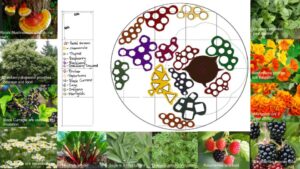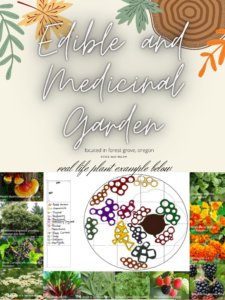Goals
see goalsThe purpose of this project is to:
- Provide opportunity to practice finding useful information
- Introduce and practice using Visual Design principles and elements
- Introduce the concept of building a self-sustaining system for a specific purpose
- Showcase the many ways plants can be used for human benefit
At the end of this project, students will be abl
e to:
- Use resources to identify opportunities and constraints that will influence design decisions
- Organize and Integrate a variety of information to solve a problem
- Present a solution that effectively addresses stated goals
- Provide a clear summary of the reasoning that led to the final result
- Produce a poster that effectively conveys complex information through the use of visual design elements and principles
- Discuss the attributes and cultural requirements of a variety of plants.
Climate Zone
see climate zoneUsing the chart below, describe the climate zone you are designing your guild for. Include average high and low temperatures, average rainfall, and times of the year when precipitation falls. Also describe the growing conditions for where your guild is located.
| Location | Forest Grove |
|---|---|
| Climate Zone | 8b |
| Average high temp | 62 |
| Average low temp | 42 |
| Annual percipitation | 45.57 inch |
| Precipitation season | 156.4 days |
| Soil type | |
| Soil Moisture | |
| Light exposure | |
External Functions
see external functionsThe purpose of designing a guild is to provide for some need outside the guild system. What would you like your guild to do for you? (such as provide food, wood, fiber, medicine, etc)
External Function 1: Medicinal
External Function 2: Food
Why did you choose these particular functions? (give some context for your choices)
In the chart below, list at least 3 plants that fullfil each of your chosen external functions. Also include the layer they occupy and the conditions that make them happy.
| Plant Name | Layer | USDA plant hardiness zone | Growing conditions | |
|---|---|---|---|---|
| Function 1 | Chamomile | 3 to 9 | Partial Shade, Rich soil, can really grow in any humidity | |
| Function 1 | Reishi Mushroom | Dead trees, brush, sawdust, underneath and on growing trees, 60%-80 humidity | ||
| Function 1 | Thyme | 6 to 8 | ||
| Function 2 | Raspberries | 4 to 8 | ||
| Function 2 | Blackberries | 5 to 10 | ||
| Function 2 | Chestnut | 6 to 9 |
Internal Functions
see internal functionsIn addition to a desired human-support output function (such as food, fiber, building material, etc) guilds should include species that support each other. Examples might include things such as mulch provider. nutrient accumulator, insect attractor, nitrogen fixer, protector, etc. List 2 “internal support” functions you think are important for your guild to thrive and prosper.
Internal Function 1: Soil Insulator
Internal Function 2: Pest Control
In the chart below, list at least 3 plants that fulfill each of your chosen internal functions, Also include the layer they occupy and the conditions that make them happy.
| Plant Name | Layer | USDA plant hardiness zone | Growing conditions | |
|---|---|---|---|---|
| Function 1 | Rhubarb | 3 to 8 | 4 to 6ft space, reproduce up to 8yrs, grow on edge | |
| Function 1 | Nasturtiums | 8 to 11 | full sun to partial shade, lower heat | |
| Function 1 | Black Currants | 3 to 8 | rich soil, morning sun, afternoon shade | |
| Function 2 | Sage | 5 to 9 | partial shade | |
| Function 2 | Oregano | 5 to 10 | moist rich soil | |
| Function 2 | Marigolds | 2 to 11 | full sunshine, withstand massive heat |
Species List
see species listUsing the information you developed above, fill the chart below with species you will include in your guild. Your guild should contain at least 7 species (one for each layer) Put an x on the chart to indicate the layer they occupy. Species must all share the same cultural requirements (same climate zone, moisture tolerance, soil type, etc)
Often (almost always) plants have multiple attributes. In addition to the primary function of the species, list any additional services that the plant provides in the “secondary function” column. Following the “stacking” and “resilience”principles, the most successful guilds will contain plants that fulfill many overlapping functions.
Species Name Chamomile Reishi Mushrooms Thyme Raspberries Black Berries Chestnuts Rhubarb Nasturtiums Black Currants
Sage Oregano Marigolds
Primary Function Medicinal Medicinal Medicinal food food food
Secondary functions
Groundcover
Herbaceous x x x
Root
Shrub
Vine
Sub canopy x
Canopy
Guild Design
see guild designMake a to-scale plan drawing that describes your guild and insert the image below. Include any relevant material that will help your audience to understand your concept. Remember to consider visual design principles as you plan the layout of your presentation.

Background Research
see background researchFor the above sections, you will be using the internet and other resources to find information that you need to complete your design. List at least 10 of your sources in the section below. For each source, write a brief description of how that source was useful to you.
- Chamomile: Plant Care & Growing Guide (thespruce.com)
- Thyme, the Fragrant Ground Cover – FineGardening
- https://www.growveg.com/plants/us-and-canada/how-to-grow-black-currant/
- Rhubarb: Planting, Growing, and Harvesting Rhubarb | The Old Farmer’s Almanac
- Crimson Sage Nursery – USDA Zone Map (crimson-sage.com)
- Blackberry Care Instructions (arborday.org)
- Raspberry Plant Care Information – How to Take Care of Raspberries (raspberry-depot.com)
- 6 Benefits of Reishi Mushroom (Plus Side Effects and Dosage) (healthline.com)
- Kousa Dogwood (Japanese Dogwood) Tree on the Tree Guide at arborday.org
- How to Grow Oregano (thespruce.com)
Poster
seeposter
Using powerpoint or some other layout software, create a 24 x 30 poster and insert your poster below. Poster should oriented towards a client and be attractive, impactful, and follow the principles of visual design (see videos on the guild resources page). Be prepared to talk about the choices you made regarding the elements you used in relation to their placement on the pag
e and the des
ired effect you want the poster to have on your client.

